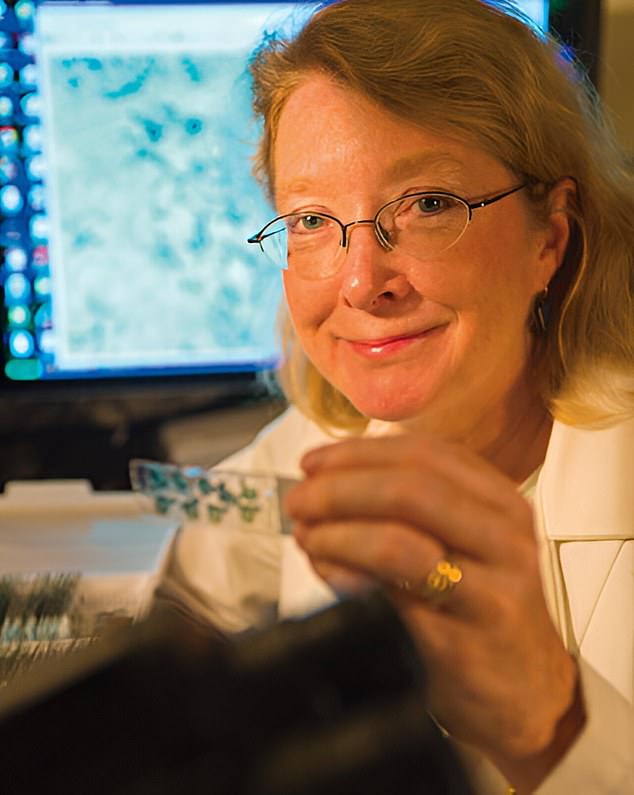Could a severe infection in the womb raise chance of autism? Scientists make ‘unexpected’ discovery after studying children’s brains
Scientists believe they have found more evidence of what causes autism and other neurological conditions.
A team from the University of Maryland discovered that inflammation stunts the growth of specific neurons in the part of the brain responsible for motor control and language, social skills and emotional regulation.
Previous research has shown that babies born with abnormalities in the cerebellum often experience neurodevelopmental disorders such as autism and schizophrenia, and animal models exposed to inflammation before birth also develop the conditions.
There are many things that can cause inflammation in the developing brains of babies, including a serious infection in the womb, according to study co-leader Dr. Seth Ament.

Dr Margaret McCarthy (pictured) co-led the research at the University of Maryland, which found that inflammation in children’s brains can disrupt the growth of two key neurons – the Golgi and Perkinje neurons
The researchers looked at the brains of 17 children who died between the ages of one and five.
Eight died of inflammatory conditions such as bacterial or viral infections or asthma, compared with the remaining nine who died of a sudden accident.
None of the children had been diagnosed with a neurological disorder before they died, and the two groups were similar in age, sex, race and ethnicity, and time since death.
The scientists found that the brains of the children who died of illness or allergy all had the same changes.
Two specific but rare types of neurons – the Golgi and Perkinje neurons – appear to have their growth disrupted due to the inflammation, meaning they are not fully developed and can lead to disorders such as autism.
Children are born with autism and cannot develop it, as far as researchers know, which means the inflammation must occur during development in the womb.
Scientists are still not entirely sure what the cause is many neurodevelopmental disorders are, but this findings could lead to more and better treatments for childhood-onset disorders.
Dr Dean Gladwin, a physician scientist at the university, said: ‘It is critical to understand these mechanisms and changes at the cellular level during brain development in the hope that one day we can develop treatments for neurodevelopmental disorders. ‘
Dr. Ament tell News week: ‘The donors in our sample experienced acute inflammation from causes such as encephalitis and severe asthma attacks.
‘In addition, some donors were identified as having experienced inflammation because their medical records indicated the use of anti-inflammatory drugs.’
Dr Ament said: ‘We looked at the cerebellum because it is one of the first brain regions to start developing and one of the last to reach maturity, but it remains understudied.
“With the fairly new technology of single-core RNA sequencing, we can look at the cellular level to see changes in the brain.”
Co-leader Professor Margaret McCarthy said: ‘This has never been done before in this age group and in the context of inflammation.
“The gene expression in the cerebella of children with inflammation was remarkably consistent.”
Dr Ament said: ‘Although rare, Purkinje and Golgi neurons have critical functions.
‘During development, Purkinje neurons form synapses that connect the cerebellum to other brain regions involved in cognition or emotional control, while Golgi neurons coordinate communication between cells within the cerebellum.
“Disruption of any of these developmental processes may explain how inflammation contributes to conditions such as autism spectrum disorders and schizophrenia.”
He said, as with many diseases, both genetics and the environment — in this case, inflammation — likely contribute to the risk of developing the disorders.
Dr Ament said this is why understanding the roles of specific cells within brain regions – as well as how they interact with genes to influence brain function – is crucial to developing treatments for brain disorders, such as autism and schizophrenia, as well as find others. including dementia, Parkinson’s disease, or substance use disorders.
He told Newsweek: ‘Dr. McCarthy previously found a postnatal critical period in rats during which inflammation blunts the development of Purkinje neurons, so it was very encouraging for us to see similar effects in humans.
‘In contrast, our findings for Golgi neurons were more unexpected and open a new line of investigation.’
The new study, published in the journal Science Translational Medicineis part of a collection of more than 20 papers describing the development and diversity of cell types in the human brain.
While the research may provide additional information that could help generate new treatments for conditions such as schizophrenia and autism, it is not clear whether targeting inflammation will completely stop its effects on brain development.
Autism affects one in 36 children, meaning more than 90,000 children are born with the developmental disorder in the US each year.
It is characterized by difficulties with social communication and interaction, difficulties in expressing oneself and repetitive behaviors and interests.
